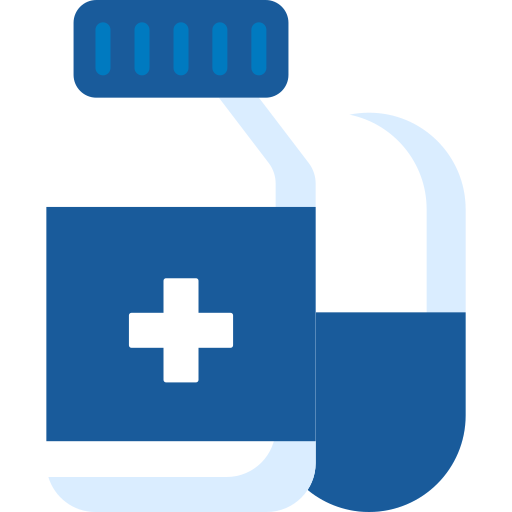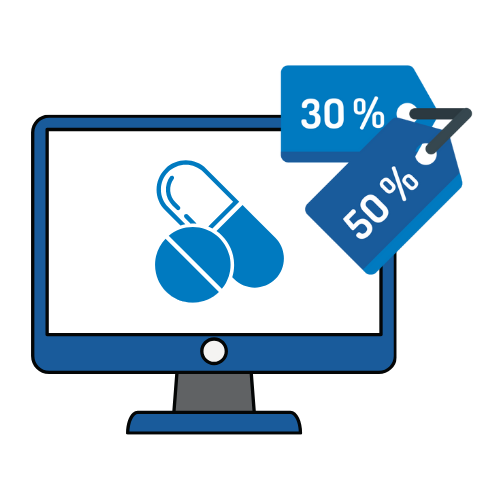Atorvastatin vs Crestor: Differences & Similarities
- Last Updated: January 11th, 2024
Key takeaways:
Atorvastatin and Crestor are both statins, medicines that lower "bad" cholesterol levels.
They work by blocking an enzyme in the liver called HMG - CoA reductase, which helps to produce cholesterol.
Both drugs are effective at reducing LDL (low-density lipoprotein) or 'bad' cholesterol and increasing HDL (high-density lipoprotein) or 'good' cholesterol, but Crestor is generally more potent.
The dosage for each medication varies depending on individual health conditions; high doses can lead to faster results but also increased risk of side effects.
An Overview of Atorvastatin vs Crestor
On this page, we’ll provide an in-depth comparison of Atorvastatin vs Crestor, discuss the nuances of these two popular statin drugs, analyze the effectiveness of each drug, and much more.

Intro to Atorvastatin and Crestor Cholesterol Drugs
Are you finding it difficult to understand the differences between Atorvastatin and Crestor?
You’re not alone.
These medications, both classified as a statin drug, are commonly used for managing high cholesterol and mitigating heart disease risk.
Table of Contents
Understanding Cholesterol and the Importance of Cholesterol Medication
In this section, we delve into the types of cholesterol and how it affect our body’s functions, elucidating the significant benefits that come with effectively lowering cholesterol levels through proper medication.
Types of cholesterol
Cholesterol, a fatty substance present in your blood, comes in two main types.
Low-density lipoprotein (LDL) cholesterol often gets tagged as the “bad” variety because it can build up on the walls of your arteries and form plaques.
These plaques pose a threat to your cardiac health as they narrow the artery passage, impeding smooth blood flow and potentially leading to heart disease or stroke.
Conversely, high-density lipoprotein (HDL) cholesterol carries away LDL cholesterol from your arteries and back to the liver where it’s broken down and removed from the body.
Often referred to as “good” cholesterol, HDL helps prevent plaque buildup, thus reinforcing cardiovascular health.
The ratio between these two types determines overall cholesterol levels — managing this balance is critical for maintaining optimal health conditions.
How it affects the body
Elevated levels of LDL cholesterol, or “bad cholesterol,” can wreak havoc on the body.
The excess LDL accumulates in your arteries forming hard deposits known as plaques.
Over time, these plaques narrow the blood vessels making it difficult for blood to flow and putting strain on your heart.
This condition is what medical professionals call atherosclerosis which increases your risk of experiencing heart attacks and strokes.
Statins like Atorvastatin and Crestor come into play to combat the damaging effects of high cholesterol levels.
These prescription drugs inhibit an enzyme involved in producing cholesterol in the liver, leading to lower total cholesterol amounts circulating in your bloodstream.
By reducing bad cholesterol, statins help keep your arteries clear ensuring smooth transport of oxygen-rich blood throughout every organ system including vital ones such as the brain and heart saving you from severe health conditions like cardiovascular disease.
Benefits of lowering cholesterol levels
Lowering cholesterol levels can drastically enhance your quality of life and longevity.
High LDL cholesterol, often termed ‘bad cholesterol’, elevates the risk of developing heart disease because it contributes to the build-up of fatty deposits (plaques) in your arteries – a condition known as atherosclerosis.
Plaques narrow arteries, restricting blood flow and creating a perfect set-up for heart attack or stroke.
Statins such as Atorvastatin and Crestor play an essential role in reducing this risk by blocking substances needed to make cholesterol, thereby lowering overall cholesterol levels in the body.
This resultantly decreases plaque formation and promotes better cardiovascular health.
Moreover, studies have shown that statins not only lower “bad” LDL-cholesterol but also increase “good” HDL-cholesterol by 5-10%, providing additional benefits to heart health.
In essence, keeping cholesterol at healthy levels helps maintain robust cardiovascular well-being – making medications like Atorvastatin and Crestor valuable tools in managing high cholesterol.
Overview of Atorvastatin (Lipitor) and Crestor
Atorvastatin and Crestor, commonly known under the brand names Lipitor and Rosuvastatin respectively, belong to a class of drugs called statins that are prescribed by medical professionals for reducing cholesterol levels in the blood.
These drugs work by inhibiting an enzyme in your liver known as HMG-CoA reductase, thereby lowering the amount of cholesterol produced in your body.
Both Atorvastatin and Crestor are FDA-approved medicines used to treat high cholesterol and prevent cardiovascular disease — yet they have different chemical structures which influence their overall potency and effectiveness.
Remember it’s critical to consult with your healthcare provider before starting any new medication, including Atorvastatin or Crestor, to ensure its compatibility with your unique health conditions.
What they are
Atorvastatin and Crestor are potent statin drugs used to combat high cholesterol levels.
Atorvastatin, commonly known by its brand name Lipitor, contains the active drug atorvastatin that acts as an HMG CoA reductase inhibitor.
The other compound, Crestor, houses rosuvastatin as its active ingredient.
Both medications function similarly due to their single-ingredient nature which aids in treating cardiovascular diseases by lowering LDL cholesterol or “bad cholesterol”.
Despite similar functions, Crestor is considered more potent than Atorvastatin and requires lower doses for effective results.
How they work
Atorvastatin and Crestor are classified as HMG-CoA reductase inhibitors, commonly known as statins.
This specific class of drug operates by obstructing the enzyme in the liver – HMG CoA reductase – that is primarily responsible for generating cholesterol in the body.
The key result derived from using either Lipitor or Crestor involves a significant decrease in LDL cholesterol, also frequently referred to as ‘bad’ cholesterol.
These medications further add value by increasing HDL levels (also known as ‘good’ cholesterol) and reducing triglycerides in the bloodstream.
In addition to managing high cholesterol, both Atorvastatin and Crestor have been shown to lower a patient’s risk of cardiovascular disease due to their ability to reduce harmful build-up along artery walls – i.e., they effectively slow down plaque accumulation which can lead to blockages and heart complications if left untreated.
Indications for use
Atorvastatin and Crestor are prescribed for several conditions related to cardiovascular health.
These potent medications primarily tackle high cholesterol levels, aiming to reduce harmful low-density lipoprotein (LDL) in the bloodstream.
Additionally, they assist in increasing beneficial high-density lipoprotein (HDL), also known as ‘good’ cholesterol.
Both drugs effectively minimize the risk of heart attacks and strokes for patients suffering from heart disease or diabetes by preventing plaque formation in blood vessels.
If you have been diagnosed with any of these health issues, your doctor may recommend a daily regimen involving either Atorvastatin or Crestor to help manage symptoms and improve overall well-being.
However, it’s crucial not to self-diagnose or start using these FDA-approved medicines without professional medical supervision.
Potency and Dosage Comparison
In this section, we’ll delve into the differences in potency and recommended dosages for Atorvastatin and Crestor, providing essential insights that could help determine which medication may be optimal for your cholesterol management.
To learn more about these critical factors and how they might apply to you, continue reading our comprehensive comparison.
Difference in potency
Crestor (rosuvastatin) often takes the lead in terms of potency among statin drugs.
In fact, it has a reputation as the most potent statin available, exceeding others like Atorvastatin and Simvastatin at similar doses.
This high potency allows Crestor to lower low-density lipoprotein cholesterol (LDL-C), also known as “bad cholesterol,” more effectively than some other options on the market.
On the other hand, Atorvastatin is not far behind in this race for strength, showing promising results even when prescribed at high doses.
Both these drugs aim to reduce LDL-C levels, but their individual effectiveness may vary between different users due to health factors or genetic differences.
Recommended dosages
Dosages for Atorvastatin and Crestor vary, based on the individual patient’s condition.
The general starting dosage for Atorvastatin usually ranges from 10 to 20 mg per day.
On certain occasions, physicians may ramp up treatment into high-dose therapy involving a prescription of as much as 80 mg per day.
The Crestor (Rosuvastatin) dose generally starts off lower, beginning at around a modest 5 mg daily but can be escalated to a maximum level of 40 mg if deemed necessary by healthcare professionals.
It is critical that patients adhere strictly to these specified dosages and avoid self-medication or mishandling of their prescriptions in order to maintain effective cholesterol management without risking potential side effects.
Speed of Effectiveness
Especially important for those seeking immediate relief, we’ll explore how quickly Atorvastatin and Crestor can start to lower cholesterol levels, examining variables like dosage, metabolism rate, and more.
Such nuances might just affect your choice between these two medicines.
Stay with us to uncover all the details you need to make an informed decision!
How fast they work
Atorvastatin and Crestor show varying rates of effectiveness.
These types of statins usually start lowering cholesterol within a week, but it may take up to six weeks to see their full effect.
Speed also depends on individual health factors and the dosage taken.
A higher dosage generally works faster than a lower one.
However, even at maximum speed, these medications don’t instantly drop cholesterol levels — they require consistency in terms of daily use and time.
The idea is not just to temporarily decrease your cholesterol readings for your next blood test but to maintain them over time for better cardiovascular health.
While you might notice some changes early on, especially with high dosages, thorough reduction often takes several weeks.
Factors that may affect speed
The rate at which Atorvastatin and Crestor function in the body may vary based on several elements.
The lifestyle of a person plays an integral role; regular exercise and a diet low in saturated fats can potentially speed up the process.
Meanwhile, pre-existing conditions like liver or kidney problems may slow down drug metabolism, reducing its effectiveness.
Certain medications taken concurrently with these statins may also influence how quickly they work through interactions that affect absorption or elimination rates.
Another factor is genetic variance; individuals respond differently to drugs due to their unique DNA makeup.
In some cases, age and sex could contribute as well—studies have shown post-menopausal women and older adults might experience delays in drug efficacy.
Smoking habits are another crucial element since nicotine can change how our bodies react to medicine.
Lastly, varying dosages also impact the speed at which cholesterol levels drop:
Typically, higher doses of Atorvastatin or Crestor result in quicker reductions but bear increased risk of side effects such as muscle pain or liver damage.
Efficacy and Effectiveness Comparison
Dive into the scientific findings and results from various studies comparing the efficacy of Atorvastatin and Crestor, exploring their success rates in cholesterol control as well as alternate treatment options.
Studies and results
Clinical trials have shown remarkable strides in the effectiveness of both Atorvastatin and Crestor in cholesterol management.
A critical finding was that high-dose Atorvastatin and Crestor deliver similar clinical efficacy, achieving significant reductions in LDL-C levels.
Rosuvastatin 10 mg emerged as the top performer among statins for lowering LDL-C levels within a Qatari context.
Other studies highlighted Atorvastatin’s safety profile — it registered fewer adverse effects compared to other statins reviewed.
Additionally, these medications were seen to notably decrease the risk of ischemic stroke amongst patients with high cholesterol levels — this played a role in enhancing their standing as essential tools in managing heart health.
These findings further our understanding, pushing us closer to designing personalized treatments based on individual responses to medication.
Alternative treatment options
Even though statins like Atorvastatin and Crestor are widely used to reduce cholesterol levels, there exist alternatives for patients who cannot tolerate these medications or prefer a different approach.
Lifestyle modifications such as increased physical activity, healthier diet choices, and weight loss can significantly improve cholesterol profiles.
In addition to this, some may opt for supplements with natural ingredients believed to manage cholesterol levels, although the efficacy of such options is often disputed.
For instance, garlic and fish oil have been known to be utilized for heart health purposes.
However, a study indicated that supplements generally do not effectively boost heart health or adjust cholesterol when compared to statins.
Therefore it is critical that any alternative treatment plan should be discussed thoroughly with your healthcare provider before commencement.
Safety Profile
Both Atorvastatin and Crestor come with potential side effects — the blog post will break down common to severe effects of each, providing vital guidance for current users and those considering these medications.
To expand your knowledge on the safety profile of both drugs, continue reading through our in-depth examination.
Common side effects
Taking Atorvastatin or Crestor can lead to several common side effects.
Being aware of these potential effects can help individuals better manage their health while taking these medications.
Here is a list of some common side effects that may occur:
- Derangement in liver function tests: This is a frequently observed side effect of both Atorvastatin and Crestor.
- Muscle weakness or pain: Known as myopathy, this condition is more likely to occur with higher doses of these medications.
- Headaches: Some people who take these drugs report experiencing mild to moderate headaches.
- Nausea: You may feel nauseous when first starting treatment, though this usually lessens over time.
- Dizziness: It’s not uncommon for some patients to report feeling dizzy while on either Atorvastatin or Crestor.
- Gastrointestinal issues: Both drugs could cause gas, diarrhea, and constipation in some users.
- Achy muscles or joints: Apart from myopathy, you might experience general muscle aches or joint pains.
Severe side effects
Severe side effects can sometimes occur with cholesterol medications like Atorvastatin and Crestor.
However, it’s vital to note that these serious side effects are far less common than minor ones and often happen in rare circumstances:
- Atorvastatin may lead to severe muscle pain, a condition known as rhabdomyolysis. This is a breakdown of skeletal muscle that can cause kidney damage.
- Crestor may also cause rhabdomyolysis, although the risk appears to be slightly lower.
- Both drugs can potentially lead to liver problems including increased liver enzymes and hepatitis. It’s necessary for those on these medications to monitor their liver health through regular blood tests.
- Severe allergic reactions might occur with both drugs, ranging from skin rash and itching to swelling of the face or tongue.
- Uncommon yet severe side effects of Atorvastatin include a higher risk of gastrointestinal issues such as GERD (gastroesophageal reflux disease) and gastritis.
Atorvastatin & Crestor: Precautions and Interactions
Understanding the potential precautions and interactions associated with Atorvastatin and Crestor is key to maintaining overall health while taking these cholesterol-lowering drugs.
Discover how each drug may react with other medication, know which health conditions could influence their effectiveness, and learn essential safety guidelines to avoid adverse effects.
Keep reading for more detailed insights on Atorvastatin Vs Crestor.
Warnings and precautions for use
Atorvastatin and Crestor, while beneficial in managing high cholesterol levels, come with certain warnings and precautions.
Both medications have the potential to cause muscle pain and liver problems.
Users may face an increase in the risk of side effects if these drugs interact with specific antibiotics or antifungal medications.
Crestor carries a rare but noteworthy caution about possible memory issues or confusion.
However, despite these risks, it is generally accepted that the cardiovascular benefits of statins outweigh the marginal increase in side effect dangers.
Always communicate with a healthcare professional about any potential drug concerns before starting your journey with statin therapy.
For substantial savings on Atorvastatin, be sure to download our coupon from Coupon Pharm’s website.
Potential interactions with other medications
Atorvastatin and Crestor, like many medications, can interact with other drugs you may be taking.
These interactions are critical to keep in mind since they can increase the risk of toxicity or reduce the effectiveness of your cholesterol medication.
The following are some potential drug interactions:
- Certain medications can raise the plasma concentration of statins or their active metabolites, making it equivalent to taking a higher dosage.
- Crestor may have interactions with birth control pills, cimetidine, blood thinners, spironolactone, niacin, and other statin drugs.
- Combining Atorvastatin (Lipitor) and Crestor with certain medications could potentially lead to harmful interactions.
- Medications used concurrently with Atorvastatin or Crestor might require modifications to avoid potential side effects.
Switching Between Atorvastatin and Crestor
Switching between Atorvastatin and Crestor could have varying effects based on individual health factors.
It’s imperative to discuss the safe transition and consideration with your healthcare provider before making any changes.
Read more about it in our comprehensive guide below, and remember to check out our discounted drug coupons for Atorvastatin on the Coupon Pharm website.
Is it safe to switch?
Switching between Atorvastatin and Crestor is generally safe and efficient in managing cholesterol levels.
Studies indicate a favorable safety profile when transitioning from one medication to the other, especially when trying to meet specific LDL-C goals.
However, individual responses can vary because of genetics, age, dietary habits or concurrent medical conditions.
Therefore, always consult your healthcare provider before making any changes to your prescription drugs.
It’s important not just for optimum cholesterol control but also for reducing potential side effects related to statin therapy.
Remember that our website offers discount coupons on Atorvastatin simplifying the switch if it’s recommended by your doctor!
Considerations when switching
Switching between Atorvastatin and Crestor needs careful thought.
Your current cholesterol levels, lifestyle changes, drug tolerability, and the cost of medication are key factors to consider.
The potential impact of switching on your low-density lipoprotein cholesterol is also a crucial consideration since non-equipotent lipid-lowering treatments can raise these levels.
While effective in lowering cholesterol, Rosuvastatin (Crestor) might have different effects compared to Atorvastatin due to variations in signaling cascades and mechanisms of action.
Side effects may also differ between the two medications despite their similarities which adds another layer of complexity when deliberating a switch.
Always discuss any possible changes with your doctor before making the switch as they will be able to advise based on your unique health situation.
It’s important not to self-medicate or alter dosages without medical consultation as this could lead to adverse effects or reduced efficacy of treatment.
You should also note that while some patients may respond better to one drug over another, both Atorvastatin and Crestor are FDA-approved for treating high cholesterol levels – indicating their recognized safety and effectiveness at reducing related risks such as heart disease.
Conclusion: Atorvastatin vs Crestor — Which is Better for Me?
Determining whether Atorvastatin or Crestor is a more suitable choice for you involves considering various personal health factors and consulting with a healthcare provider — to explore further, continue reading this comprehensive comparison.
Factors to consider when choosing between Atorvastatin and Crestor
There are a few important factors to take into account when deciding between Atorvastatin and Crestor.
Efficacy is one of them – studies show that Rosuvastatin (Crestor) is slightly more effective at reducing LDL-C levels than Atorvastatin.
Another key consideration is tolerance: certain side effects such as muscle pain and liver problems may be more common in one drug compared to the other, which can have a significant impact on your comfort and overall health.
Dosage conversion also plays an integral role in choosing between these two drugs — healthcare professionals tend to prescribe lower doses of Crestor due to its higher potency.
Also, consider any potential drug interactions with other medications you’re currently taking or health conditions you have – both drugs interact differently with other compounds and can impact existing medical conditions diversely.
Lastly but certainly not least, cost needs attention: while Atorvastatin is available in generic form and may be less expensive, some insurance companies might cover the cost for Crestor if it’s proven more effective against your high cholesterol levels after consultation with your doctor.
Consult with your doctor for personalized recommendation.
To maximize the benefits and minimize possible risks from cholesterol medications, having a personalized treatment plan is critical.
Your healthcare provider can guide you in choosing between Atorvastatin and Crestor based on various factors.
These factors include your overall health, other prescribed medications, the severity of your high cholesterol levels, lifestyle habits and patient compliance.
This individualized approach ensures medication effectiveness while taking into account potential side effects or drug interactions.
Make sure to discuss your expectations about outcomes with the doctor — this will allow him/her to address any concerns promptly and adjust treatment plans as necessary.
Frequently Asked Questions
-
What is Atorvastatin and Crestor?
Atorvastatin (Lipitor) and Rosuvastatin (Crestor) are cholesterol-lowering medications known as HMG-CoA reductase inhibitors.
-
How do Atorvastatin and Crestor treat high cholesterol?
Both Lipitor and Crestor work by reducing LDL-C, or low-density lipoprotein cholesterol, also known as ‘bad’ cholesterol while increasing HDL, the ‘good’ cholesterol in your blood.
-
Are there any significant differences between Atorvastatin dosage compared to Crestor's?
Yes!
The recommended starting dose varies among these two brand-name drugs — consult prescribing information or a healthcare professional for initial dose guidelines based on individual risk factors.
-
Can everyone use these lipid-lowering medications safely?
Mostly yes!
However, some groups like people of Asian descent might need special care due to genetic sensitivity to these drugs hence muscle breakdown is a possible side effect that needs monitoring.
-
Is there scientific evidence supporting the efficacy of taking Crestor?
Absolutely!
Both Lipitor and Crestor have proven their effectiveness in disease control through solid scientific evidence provided in clinical practice guidelines.
-
Have product manufacturers addressed safety concerns related to using either drug?
Yes, health claims around potential risks have been FDA-approved, ensuring that product manufacturers provide accurate drug information about both medications including tangible benefits versus potential side effects.

Dr. Pharm
Pharmaceutical Drug Discount Expert


Determine your specific dosage and quantity needs to discover impressive savings opportunities.

Select from a range of available coupons for immediate use, or explore additional savings at various local pharmacies.

Simply present your chosen coupon, either in print or digital form, to your pharmacist when you collect your medication.
Coupon Pharm works relentlessly to gather prices, coupons, and savings tips for prescriptions at virtually every U.S. pharmacy to help you fight against high drug prices, price gouging and an out-of-control health care system.
Bottom line: Coupon Pharm offers unbiased price and coupon information to help you compare and save the most money on your prescriptions whether it’s with our coupons or a pharmacy’s already low retail price.
Nobody else does that!
Get Atorvastatin for as low as $7.25, which is 89% off the average retail price of $67.84 for the most common version, by using a Coupon Pharm discount card.
Get Adderall for as low as $10.50, which is 79% off the average retail price of $50.60 for the most common version, by using a Coupon Pharm discount card.
Get Lisinopril for as low as $4.36, which is 74% off the average retail price of $16.46 for the most common version, by using a Coupon Pharm discount card.
Get Metformin for as low as $4.33, which is 69% off the average retail price of $13.79 for the most common version, by using a Coupon Pharm discount card.
Get Hydrocodone for as low as $12.23, which is 89% off the average retail price of $100.03 for the most common version, by using a Coupon Pharm discount card.


Determine your specific dosage and quantity needs to discover impressive savings opportunities.

Select from a range of available coupons for immediate use, or explore additional savings at various local pharmacies.

Simply present your chosen coupon, either in print or digital form, to your pharmacist when you collect your medication.
